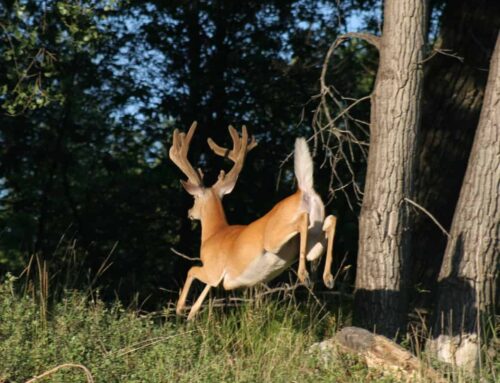Right now is the time to establish a few mineral licks on your hunting land. Licks are easy and relatively inexpensive to make and maintain, and they serve two purposes: 1) provide vitamins for all the deer, from bucks growing new antlers to pregnant does getting ready to have fawns; and 2) they are top spots for you to set trail cameras and monitor bucks all summer.
Science of Minerals
“As land managers and hunters, we supply minerals for similar results in deer that we see in livestock that share the same environment,” says Dr. Brian Dorcey, a lifelong deer hunter who received his Doctor of Veterinary Medicine at Iowa State. “Some of the well documented benefits of supplying supplemental minerals in cattle, sheep, and goats include increases in milk production, growth rate, ability to fight off disease, reproductive efficiency, and a better ability to deal with stress. We believe the benefits of providing minerals to a deer herd can be seen in all aspects of a deer’s life.”
Mineral and Camera Sites
On one of the farms that I hunt in Virginia, my friend Jack and I have 6 licks scattered strategically across 800 acres of woods. We begin replenishing these sites with minerals in March, and the deer hit them immediately. The bucks on this farm know where the licks are and have been checking them regularly for years. But most anywhere you make a new lick, deer will find it quickly.
“You will see the highest usage of a mineral lick by deer during spring green up and lasting to about the first frost,” says Dr. Dorcey, who serves as a field specialist for Anilogics Outdoors.
In May, when the new antlers are up and growing, we start running trail cameras at the licks, and keep them rolling through July. During that time we’ll get hundreds and even thousands of deer images. Immediately we can see what kind of rack year it is shaping up to be, which is something every bow hunter wants and needs to know.
We wade through the picture mountain of does and young bucks and start focusing on the mature deer. Any thick 8- or 10-pointer in the 130-class catches our eye and we really hone in on a buck in the 140 range.
How to Build a Lick
Locate your licks strategically across the property you hunt. The corners and edges of crop fields and food plots are good spots, especially where thick cover is nearby. All our licks are fairly close to main deer trails, where bucks and does can veer over to check them with minimal effort. Two of our best sites are near creek crossings back in the woods.
Look for a flat spot with a good tree for a camera within 10 to 12 feet. Clear a spot 6 to 8 feet in diameter, and rake away old leaves and grass down to bare soil.
Apply and scatter a light coat of loose minerals. We use Mineral Dirt 180, which contains a “health pack” formulated to provide key minerals for the growth and health of does and bucks.
“We have performed tissue analysis on harvested animals that consumed Mineral Dirt 180, and it shows a superior tissue mineral profile in the supplemented animals versus animals that were not supplemented,” says Dr. Dorcey.
Generally we use half a bag of minerals at a lick. I mix the minerals lightly into the dirt with a rake or my boots. At some sites we set out mineral blocks, which are super convenient to use.
We refresh our licks with a new application of minerals once a month. It is fun to watch how the most active sites grow. As deer dig for the minerals, the holes get bigger and deeper. We have a couple of old licks deep enough to hide half a buck!
I end with this important note. Here in Virginia, and in some other states, using minerals to supplement the diet of deer is legal during spring and summer, but not permitted from September 1 through the end of hunting season. State laws on using minerals and attractants vary widely, so check your game regulations carefully.
How many of you do mineral licks, and how do they work out for you?









I use Mineral sites here in Arizona for my coues bucks year round and refresh them every two months or so. We used to be able to put sugar, Kool-Aid and other attractants mixed in with them up until about 2 years ago when the regulations changed and now prohibit bait sites, but if you’re able to add something sweet to the site in your state I suggest giving it a try because they absolutely love hitting the sites when they can get a treat along with the minerals lol I like to put a block of goat mineral in the middle of my actual salt site which I dig about 3 inches deep then mix the salt in with the dirt and water to solidify it. I’ve found that if I don’t mix the water in with the dirt and salt to have it set like concrete does, that the first big rain will sometimes wash away a site here in AZ especially in Mountain country. Good luck everyone with your sites!